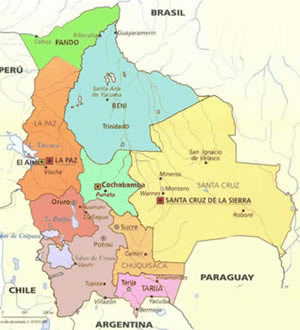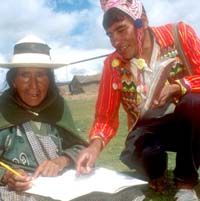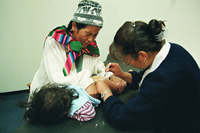| Home > Bolivia |
BOLIVIA:
Country Profile of Bolivia
The Republic of Bolivia, named after Simón Bolívar, is a landlocked country in central South America. It is bordered by Brazil on the north and east, Paraguay and Argentina on the south, and Chile and Peru on the west.
|
☻Capital: - La Paz (government) - Sucre (legal) ☻Area: - Total: 1,098,581 km˛ (28th) 424,163 sq mi ☻Independence: - from Spain: August 6, 1825 |
☻Official languages: - Spanish, Aymara, Quechua ☻Population: - 2005 census : 8,857,870 - 2012 estimate: 10,389,913 - Density: 9/km˛ - 23/sq mi |
Geography of Bolivia:
 Bolivia sits aside the Andes in the west-central part of the South American continent. The area of Bolivia is 1,098,581 square kilometers, and is about the size of Texas and California combined, or twice the size of Spain. Bolivia borders five other South American countries. Brazil is to the east and north, Paraguay is to the southeast, Argentina is to the south, Chile is to the southwest and Peru is to the northwest. Bolivia´s geography is made up of different types of land structures and mountain ranges. The Andes mountains is made up of three geographic zones: the Altiplano, the Yungas and the tropical lowlands or plains (llanos) of the eastern lowlands, or Oriente. The ranges of the Andes move in two grand parallel ranges or cordilleras. The western range (Cordillera Occidental) runs along the Peruvian and Chilean borders whereas the eastern range (Cordillera Oriental) moves from Peru to Argentina. Lake Titicaca, the highest navigable lake in the world, is also located between Bolivia and Peru. Bolivia has a population of about 9,100,000 people and the capital of Bolivia is La Paz. Despite Bolivia´s many small communities, the country has several other large cities such as Santa Cruz, Cochabamba, El Alto, and Oruro.
Bolivia sits aside the Andes in the west-central part of the South American continent. The area of Bolivia is 1,098,581 square kilometers, and is about the size of Texas and California combined, or twice the size of Spain. Bolivia borders five other South American countries. Brazil is to the east and north, Paraguay is to the southeast, Argentina is to the south, Chile is to the southwest and Peru is to the northwest. Bolivia´s geography is made up of different types of land structures and mountain ranges. The Andes mountains is made up of three geographic zones: the Altiplano, the Yungas and the tropical lowlands or plains (llanos) of the eastern lowlands, or Oriente. The ranges of the Andes move in two grand parallel ranges or cordilleras. The western range (Cordillera Occidental) runs along the Peruvian and Chilean borders whereas the eastern range (Cordillera Oriental) moves from Peru to Argentina. Lake Titicaca, the highest navigable lake in the world, is also located between Bolivia and Peru. Bolivia has a population of about 9,100,000 people and the capital of Bolivia is La Paz. Despite Bolivia´s many small communities, the country has several other large cities such as Santa Cruz, Cochabamba, El Alto, and Oruro.
Education in Bolivia:
 Due to the politics of Bolivia combined with the poverty, education in Bolivia was slow to advance. During the early 1900´s, missionaries from Belgium arrived and over the course of 30 years established the main primary school system that takes place in Bolivia today. It was not until 1956 when legislation began to lay the groundwork for a public educational school system in the country of Bolivia. The illiteracy rate remains high for Bolivia and many children today still are unable to complete all years of schooling. Like many other countries in South America, children are urged to be at home to help with work for the house and for the family. Due to this, their education suffers, and aids to the rising population of undereducated and illiterate adults. On average, children from rural areas attend school for 4.2 years, while children in urban areas receive more with an average of 9.4 years of education. It is also found through studies that there is a gender divide in the educational system. Females, on average, receive about 1.5 years less schooling than males. The female illiteracy rate is 19.6% while that for males is 7.4%. The country’s illiteracy level as a whole, 13– 14%, is comparably higher than in other countries in South America. This is mainly due to the lack of funding given towards the educational system. Some significant changes have been made as of late, which has helped teaching curriculum and training. With universities emerging in larger cities throughout Bolivia, upper education is promoting the arts, medicine, and science.
Due to the politics of Bolivia combined with the poverty, education in Bolivia was slow to advance. During the early 1900´s, missionaries from Belgium arrived and over the course of 30 years established the main primary school system that takes place in Bolivia today. It was not until 1956 when legislation began to lay the groundwork for a public educational school system in the country of Bolivia. The illiteracy rate remains high for Bolivia and many children today still are unable to complete all years of schooling. Like many other countries in South America, children are urged to be at home to help with work for the house and for the family. Due to this, their education suffers, and aids to the rising population of undereducated and illiterate adults. On average, children from rural areas attend school for 4.2 years, while children in urban areas receive more with an average of 9.4 years of education. It is also found through studies that there is a gender divide in the educational system. Females, on average, receive about 1.5 years less schooling than males. The female illiteracy rate is 19.6% while that for males is 7.4%. The country’s illiteracy level as a whole, 13– 14%, is comparably higher than in other countries in South America. This is mainly due to the lack of funding given towards the educational system. Some significant changes have been made as of late, which has helped teaching curriculum and training. With universities emerging in larger cities throughout Bolivia, upper education is promoting the arts, medicine, and science.
Health in Bolivia:
 Health conditions in Bolivia are very poor due to lack of doctors and hospitals along with poor hygiene. This is most noted especially outside of urban areas and around the rural areas. The most notable diseases are tuberculosis, malaria, hepatitis, chagas disease, and acute respiratory disease. Along with maladies that are spreading through the country, malnutrition is a severe problem in Bolivia. In the year 2000, 27 percent of children under the age of five are said to have malnutrition. In the same year, only 79 percent of the people had access to drinking water that is considered safe and only 66 percent of the people had adequate sanitation. In 1999, statistics show that the lack of physicians in healthcare is a leading cause in the problems found in the healthcare system. The estimates show that there are only 1.3 physicians and 1.7 hospital beds for ever 1,000 people. In Bolivia there are more than 3,000 public and private health care facilities. Since the World Health Initiative Program in 1991, health conditions in Bolivia have improved and the Bolivian government is taking a greater stand towards improving the overall healthcare system in Bolivia.
Health conditions in Bolivia are very poor due to lack of doctors and hospitals along with poor hygiene. This is most noted especially outside of urban areas and around the rural areas. The most notable diseases are tuberculosis, malaria, hepatitis, chagas disease, and acute respiratory disease. Along with maladies that are spreading through the country, malnutrition is a severe problem in Bolivia. In the year 2000, 27 percent of children under the age of five are said to have malnutrition. In the same year, only 79 percent of the people had access to drinking water that is considered safe and only 66 percent of the people had adequate sanitation. In 1999, statistics show that the lack of physicians in healthcare is a leading cause in the problems found in the healthcare system. The estimates show that there are only 1.3 physicians and 1.7 hospital beds for ever 1,000 people. In Bolivia there are more than 3,000 public and private health care facilities. Since the World Health Initiative Program in 1991, health conditions in Bolivia have improved and the Bolivian government is taking a greater stand towards improving the overall healthcare system in Bolivia.Funded in part by international organizations such as the World Bank, the system is in the midst of reform. The number of physicians practicing has doubled in recent years. Priorities include providing basic health care to more children and women and expanding immunization. Problems such as diarrhea and tuberculosis, leading causes of death among children, are tackled. Bolivia's health care expenditures are now a little over 4 percent of its national budget, which is on a par with regional norms.
With the private sector meeting only a small demand for services, 70% of the population must be covered by the public sector. However, only half the population that should be served by the public sector actually has access to it. This means that about 35 to 40% of Bolivia’s population is currently without coverage by the health insurance system.
Politics in Bolivia:
.JPG) Bolivia´s 1967 constitution which was revised in 1994, gives a balanced executive, legislative and judicial powers for the government. The National Congress, however, is overshadowed by a traditionally strong executive. Unfortunately, there has been much corruption in the Supreme Court and in the lower courts combined with inefficiency for balanced executive, legislative, and judicial powers. The revisions in the constitution in 1994 has helped with some of the problems, and through further laws, the government has begun far-reaching reforms in the judicial system and processes. The traditionally strong executive, however, tends to overshadow the National Congress.
Bolivia´s 1967 constitution which was revised in 1994, gives a balanced executive, legislative and judicial powers for the government. The National Congress, however, is overshadowed by a traditionally strong executive. Unfortunately, there has been much corruption in the Supreme Court and in the lower courts combined with inefficiency for balanced executive, legislative, and judicial powers. The revisions in the constitution in 1994 has helped with some of the problems, and through further laws, the government has begun far-reaching reforms in the judicial system and processes. The traditionally strong executive, however, tends to overshadow the National Congress. In more recent years, the political state of Bolivia has included fraud, exploitation and dishonesty. After President Hugo Banzer resigned his position back in 2001 due to illness, vice-president Jorge Quiroga took over. During the 2002 elections, Evo Morales of the Movement Toward Socialism ( MAS ) was one of the candidates for president, along with Sanchez de Lozada. The United States had claimed that foreign aid would be cut off should electorates vote for Morales. Sanchez won with Morales only a few points behind him though there were many claims that there was electoral fraud. During the year 2003, strikes and blockades began due to a conflict over the gas reserve in Bolivia. Sanchez de Lozada submitted his resignation due to pressure from protestors and left for the United States. The presidency was passed onto Carlos Mesa, due to constitutional order, though due to his inability to handle the conflicts arising in Bolivia, he resigned as well. 2005 brought along Mr. Eduardo Rodriguez Veltzé, the President of the Supreme Court, into office. With reconstruction to the constitution, a full renewal of Parliament and the Presidential Election occurred in December of 2005.
Due to the criminalization of coca farming, economic reforms and rising power of the indigenous population through MAS, Evo Morales won the presidency during the elections of 2005. Since Morales has been elected president, the increase in minimum wage has risen and he has delivered his promises to nationalize the natural gas fields of Bolivia.
His administration has focused on the implementation of leftist policies, reduction of poverty and combating the influence of the USA and transnational corporations in Bolivia. Morales has received international acclaim for supporting indigenous rights and anti-imperialism. On the other hand, some human rights organizations have stated that many of policies and actions of the Morales government have eroded the rule of law and threaten to weaken the situation of human rights in Bolivia.